Gibilisco S. Everyday Math Demystified: A Self-Teaching Guide
Подождите немного. Документ загружается.


SOLUTION 15-5
Because the curve is a straight line, the speed is constant; we already know
it is 2.0 meters per second. Therefore, v
avg
¼ 2.0 meters per second between
any two points in time shown in the graph.
PROBLEM 15-6
Examine curve B in Fig. 15-5. What can be said about the instantaneous
speed of the object whose motion is described by this curve?
SOLUTION 15-6
The object starts out moving relatively fast, and the instantaneous speed
decreases with the passage of time.
PROBLEM 15-7
Use visual approximation in the graph of Fig. 15-5. At what time t is
the instantaneous speed v
inst
of the object described by curve B equal to
2.0 meters per second?
SOLUTION 15-7
Use a straight-edge to visualize a line tangent to curve B whose slope is the
same as that of curve A. That is, find the straight line, parallel to line A, that
is tangent to curve B. Then locate the point on curve B where the line touches
curve B. Finally, draw a line straight down, parallel to the distance (d) axis,
until it intersects the time (t) axis. Read the value off the t axis. In this exam-
ple, it appears to be approximately t ¼ 3.2 seconds.
PROBLEM 15-8
Use visual approximation in the graph of Fig. 15-5. Consider the object
whose motion is described by curve B. At the point in time t where the instan-
taneous speed v
inst
is 2.0 meters per second, how far has the object traveled?
SOLUTION 15-8
Locate the same point that you found in Problem 15-7, corresponding to the
tangent point of curve B and the line parallel to curve A. Draw a horizontal
line to the left, until it intersects the distance (d) axis. Read the value off the
d axis. In this example, it looks like it’s about d ¼ 11 meters.
VELOCITY IS A VECTOR
Velocity has two components: speed and direction. Thus, it is a vector quan-
tity. You can’t express velocity without defining both of these components.
In the earlier example of a car driving along a highway from one town to
CHAPTER 15 How Things Move 371
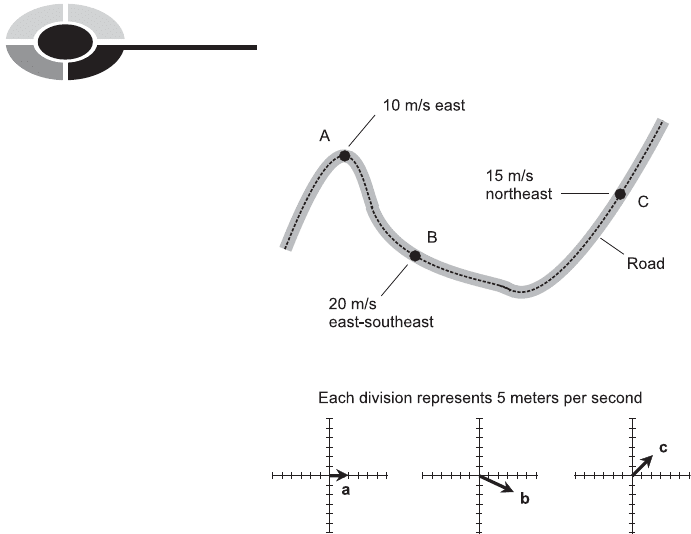
another, the car’s speed might be constant, but its velocity changes never-
theless. If you’re moving along at a constant speed of 25 meters per second
(25 m/s) and then you come to a bend in the road, your velocity changes
because your direction changes.
Vectors can be graphically illustrated as line segments with arrowheads.
The speed component of a velocity vector is denoted by the length of the
line segment, and the direction is denoted by the orientation of the arrow.
In Fig. 15-6, three velocity vectors are shown for a car traveling along a
curving road. In this case, imagine the car moving generally from left to right.
Three points are shown, called A, B, and C. The corresponding vectors are
a, b, and c. Both the speed and the direction of the car change with time.
HOW VELOCITY IS DETERMINED
Velocity can be measured by using a speedometer in combination with
some sort of device that indicates the instantaneous direction of travel.
In a car, this can be a magnetic compass. In high-end vehicles, GPS receiving
equipment can indicate the instantaneous direction in which motion occurs.
But in a strict sense, even a speedometer and a compass or GPS receiver
don’t tell the whole story unless you’re driving on a flat plain or prairie.
In mid-state South Dakota, a speedometer and compass can define the
Fig. 15-6. Velocity vectors a, b, and c for a car at three points (A, B, and C) along a road.
PART 4 Math in Science
372

instantaneous velocity of your car, but when you get into the Black Hills,
you’ll have to include a clinometer (a device for measuring the steepness
of the grade you’re ascending or descending) to get an absolutely perfect
indication of your velocity.
Two-dimensional direction components can be denoted either as compass
(azimuth) bearings, or as angles measured counterclockwise with respect
to the axis pointing ‘‘east.’’ The former system is preferred by hikers, navi-
gators, and most people in real-world situations. The latter scheme is
preferred by theoretical physicists and mathematicians. In Fig. 15-6, the
azimuth bearings of vectors a, b, and c are approximately 908, 1308, and 458,
respectively. These correspond to points of the compass called east (E),
east-southeast (ESE), and northeast (NE).
A three-dimensional velocity vector consists of a magnitude component
and two direction angles. One of the angles is the azimuth, and the other is
called elevation, measured in degrees above the horizontal (positive angles) or
below it (negative angles). The elevation angle can be as small as 908
(straight down) or as large as þ908 (straight up). The horizontal direction is
indicated by an elevation angle of 08. Elevation angle should not be confused
with elevation above or below sea level. That’s an entirely different thing,
measured in meters.
Acceleration
Acceleration is an expression of the rate of change in the velocity of an object.
This can occur as a change in speed, a change in direction, or both.
Acceleration can be defined in one dimension (along a straight line), in two
dimensions (within a flat plane), or in three dimensions (in space), just as
can velocity. Acceleration sometimes takes place in the same direction as
an object’s velocity vector, but this is not necessarily the case.
ACCELERATION IS A VECTOR
Acceleration, like velocity, is a vector quantity. Sometimes the magnitude of
the acceleration vector is called ‘‘acceleration,’’ and is usually symbolized
by the lowercase italic letter a. But technically, the vector expression should
be used; it is normally symbolized by the lowercase bold letter a.
In our previous example of a car driving along a highway, suppose the
speed is constant at 25 m/s. The velocity changes when the car goes around
CHAPTER 15 How Things Move 373
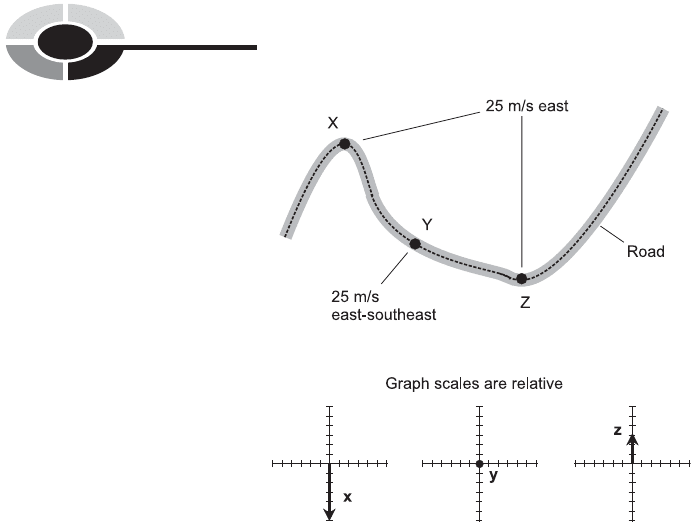
curves, and also if the car crests a hilltop or bottoms-out in a ravine or valley
(although these can’t be shown in this two-dimensional drawing). If the car is
going along a straight path, and its speed is increasing, then the acceleration
vector points in the same direction that the car is traveling. If the car puts
on the brakes, still moving along a straight path, then the acceleration vector
points exactly opposite the direction of the car’s motion.
Acceleration vectors can be graphically illustrated as arrows. Figure 15-7
illustrates acceleration vectors for a car traveling along a level, but curving,
road at a constant speed of 25 m/s. Three points are shown, called X, Y, and
Z. The corresponding acceleration vectors are x, y, and z . Because the
speed is constant and the road is level, acceleration only takes place where
the car encounters a bend in the road. At point Y, the road is essentially
straight, so the acceleration is zero (y ¼ 0). The zero vector is shown as a
point at the origin of a vector graph.
HOW ACCELERATION IS DETERMINED
Acceleration magnitude is expressed in meters per second per second, also
called meters per second squared (m/s
2
). This seems esoteric at first. What
does s
2
mean? Is it a ‘‘square second’’? What in the world is that? Forget
about trying to imagine it in all its abstract perfection. Instead, think of it
Fig. 15-7. Acceleration vectors x, y, and z for a car at three points (X, Y, and Z) along a
road. The magnitude of y is 0 because there is no acceleration at point Y.
PART 4 Math in Science
374
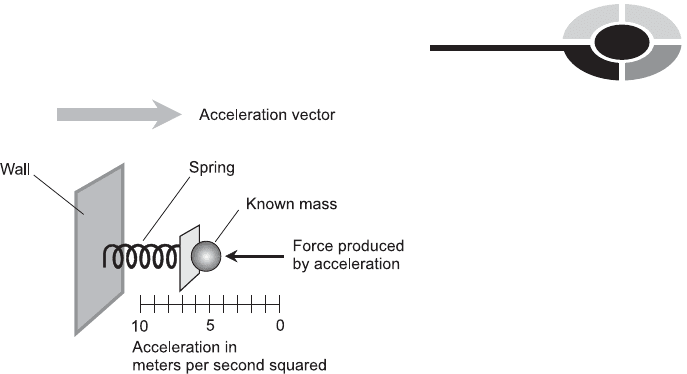
in terms of a concrete example. Suppose you have a car that can go from a
standstill to a speed of 26.8 m/s in 5 seconds. Suppose that the acceleration
rate is constant from the moment you first hit the gas pedal until you have
attained a speed of 26.8 m/s on a level straightaway. Then you can calculate
the acceleration magnitude:
a ¼ð26:8m=sÞ=ð5sÞ¼5:36 m=s
2
The expression s
2
translates, in this context, to ‘‘second, every second.’’ The
speed in the above example increases by 5.36 meters per second, every second.
Acceleration magnitude can be measured in terms of force against mass.
This force, in turn, can be determined according to the amount of distortion
in a spring. The force meter shown in Fig. 15-4 can be adapted to make
an acceleration meter, more technically known as an accelerometer, for
measuring acceleration magnitude.
Here’s how a spring type accelerometer works. A functional diagram is
shown in Fig. 15-8. Before the accelerometer can be used, it is calibrated in a
lab. For the accelerometer to work, the direction of the acceleration vector
must be in line with the spring axis, and the acceleration vector must point
outward from the fixed anchor toward the mass. This produces a force on
the mass. The force is a vector that points directly against the spring, exactly
opposite the acceleration vector.
A common weight scale can be used to indirectly measure acceleration.
When you stand on the scale, you compress a spring or balance a set of
masses on a lever. This measures the downward force that the mass of your
body exerts as a result of a phenomenon called the acceleration of gravity.
The effect of gravitation on a mass is the same as that of an upward
Fig. 15-8. An accelerometer. This measures the magnitude only, and must be properly
oriented to provide an accurate reading.
CHAPTER 15 How Things Move 375

acceleration of approximately 9.8 m/s
2
. Force, mass, and acceleration are
interrelated as follows:
F ¼ ma
That is, force is the product of mass and acceleration. This formula is
so important that it’s worth remembering, even if you aren’t a scientist. It
quantifies and explains a lot of things in the real world, such as why it
takes a fully loaded semi truck so much longer to get up to highway
speed than the same truck when it’s empty, or why, if you drive around
a slippery curve too fast, you risk sliding off the road.
Suppose an object starts from a dead stop and accelerates at an average
magnitude of a
avg
in a straight line for a period of time t. Suppose after this
length of time, the distance from the starting point is d. Then this formula
applies:
d ¼ a
avg
t
2
=2
In the above example, suppose the acceleration magnitude is constant; call it
a. Let the instantaneous speed be called v
inst
at time t. Then the instantaneous
speed is related to the acceleration magnitude as follows:
v
inst
¼ at
PROBLEM 15-9
Suppose two objects, denoted by curves A and B in Fig. 15-9, accelerate
along straight-line paths. What is the instantaneous acceleration a
inst
at
t ¼ 4 seconds for object A?
SOLUTION 15-9
The acceleration depicted by curve A is constant, because the speed increases
at a constant rate with time. (That’s why the graph is a straight line.) The
number of meters per second squared does not change throughout the time
span shown. In 10 seconds, the object accelerates from 0 m/s to 10 m/s;
that’s a rate of speed increase of one meter per second per second (1 m/s
2
).
Therefore, the acceleration at t ¼ 4 seconds is a
inst
¼ 1 m/s
2
.
PROBLEM 15-10
What is the average acceleration a
avg
of the object denoted by curve A in
Fig. 15-9, during the time span from t ¼ 2 seconds to t ¼ 8 seconds?
SOLUTION 15-10
Because the curve is a straight line, the acceleration is constant; we already
know it is 1 m/s
2
. Therefore, a
avg
¼ 1 m/s
2
between any two points in time
shown in the graph, including the two points corresponding to t ¼ 2 seconds
and t ¼ 8 seconds.
PART 4 Math in Science
376
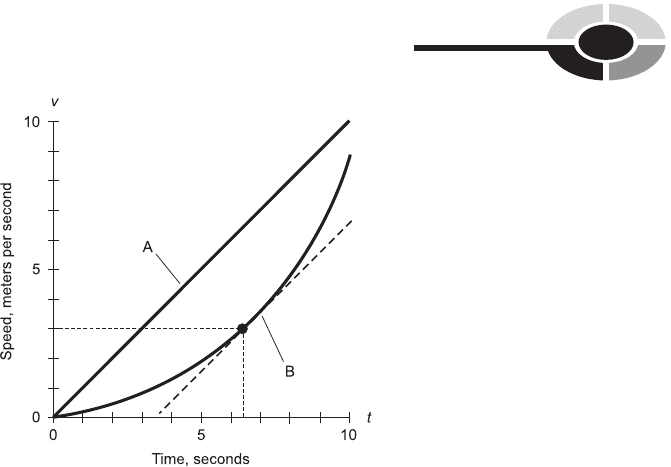
PROBLEM 15-11
Examine curve B in Fig. 15-9. What can be said about the instantaneous
acceleration of the object whose motion is described by this curve?
SOLUTION 15-11
The object starts out accelerating slowly, and as time passes, its instantaneous
rate of acceleration increases.
PROBLEM 15-12
Use visual approximation in the graph of Fig. 15-9. At what time t is the
instantaneous acceleration a
inst
of the object described by curve B equal to
1 m/s
2
?
SOLUTION 15-12
Use a straight-edge to visualize a line tangent to curve B whose slope is the
same as that of curve A. Then locate the point on curve B where the line
touches curve B. Finally, draw a line straight down, parallel to the speed
(v) axis, until it intersects the time (t) axis. Read the value off the t axis.
Here, it appears to be about t ¼ 6.3 seconds.
PROBLEM 15-13
Use visual approximation in the graph of Fig. 15-9. Consider the object
whose motion is described by curve B. At the point in time t where the
instantaneous acceleration a
inst
is 1 m/s, what is the instantaneous speed,
v
inst
, of the object?
Fig. 15-9. Illustration for Problems 15-9 through 15-13.
CHAPTER 15 How Things Move 377

SOLUTION 15-13
Locate the same point that you found in Problem 15-12, corresponding to the
tangent point of curve B and the line parallel to curve A. Draw a horizontal
line to the left, until it intersects the speed (v) axis. Read the value off the
v axis. In this example, it looks like it’s about v
inst
¼ 3.0 m/s.
Momentum
Momentum is an expression of ‘‘heft in motion,’’ the product of an object’s
mass and its velocity. Momentum, like velocity, is a vector quantity, and
its magnitude is expressed in kilogram meters per second (kg m/s).
MOMENTUM AS A VECTOR
Suppose the speed of an object (in meters per second) is v, and the mass of the
object (in kilograms) is m. Then the magnitude of the momentum, p, is their
product:
p ¼ mv
This is not the whole story. To fully describe momentum, the direction, as
well as the magnitude, must be defined. That means we must consider the
velocity of the mass in terms of its speed and direction. (A 2-kg brick flying
through your east window is not the same as a 2-kg brick flying through
your north window.) If we let v represent the velocity vector and p represent
the momentum vector, then we can say this:
p ¼ mv
IMPULSE
The momentum of a moving object can change in three different ways:
*
A change in the mass of the object.
*
A change in the speed of the object.
*
A change in the direction of the object’s motion.
Let’s consider the second and third of these possibilities together; then this
constitutes a change in the velocity.
PART 4 Math in Science
378
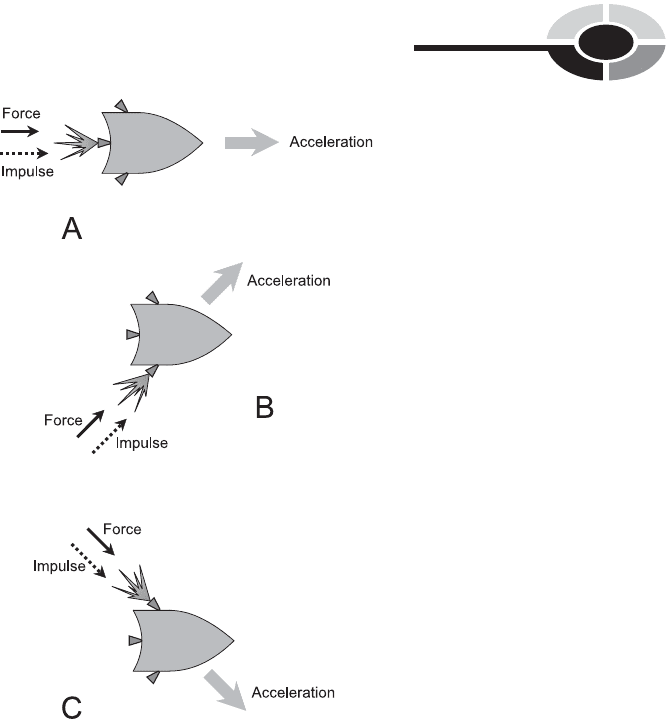
Let’s put our everyday-world time clock into ‘‘future mode.’’ Imagine a
massive space ship, coasting along a straight-line path in interstellar space.
Consider a point of view, or reference frame, such that the velocity of the ship
can be expressed as a vector pointing in a certain direction. A force F can be
applied to the ship by firing a rocket engine. Imagine that there are several
engines on the ship, one intended for driving it forward at increased speed,
and others capable of changing the vessel’s direction. If any engine is fired for
t seconds with a force vector of F newtons (as shown by the three examples in
Fig. 15-10), then the product Ft is called the impulse. Impulse is a vector,
symbolized by the uppercase boldface letter I, and its magnitude is expressed
in kilogram meters per second (kg m/s). Here’s the formula:
I ¼ Ft
Fig. 15-10. Three ways in which an impulse can cause a space ship to accelerate. At A,
getting the ship to move straight ahead at higher speed. At B and C, getting the ship to turn.
CHAPTER 15 How Things Move 379

Impulse on an object always produces a change in the object’s velocity.
That’s a good thing; it is the purpose of the rocket engines in our space ship!
Recall the above formula concerning mass m, force F, and acceleration a:
F ¼ ma
Substitute ma for F in the equation for impulse. Then we get this:
I ¼ðmaÞt
Now remember that acceleration is a change in velocity per unit time.
Suppose the velocity of the space ship is v
1
before the rocket is fired, and
v
2
afterwards. Then, assuming the rocket engine produces a constant force
while it is fired:
a ¼ðv
2
v
1
Þ=t
We can substitute in the previous equation to get
I ¼ mððv
2
v
1
Þ=tÞt ¼ mv
2
mv
1
This means the impulse is equal to the change in momentum.
We have just derived an important law of real-world motion. Impulse is
expressed in kilogram-meters per second (kg m/s), just as is momentum.
You might think of impulse as momentum in another form. When an object
is subjected to an impulse, the object’s momentum vector p changes. The
vector p can grow larger or smaller in magnitude, or it can change direction,
or both of these things can happen.
PROBLEM 15-14
Suppose a truck having a mass of 2000 kg moves at a constant speed of
20 m/s in a northerly direction. A braking impulse, acting in a southerly
direction, slows the truck down to 15 m/s, but it still moves in a northerly
direction. What is the impulse responsible for this change in speed?
SOLUTION 15-14
The original momentum, p
1
, is the product of the mass and the initial
velocity:
p
1
¼ 2000 kg 20 m =s ¼ 40ó000 kg m=s
in a northerly direction
The final momentum, p
2
, is the product of the mass and the final velocity:
p
2
¼ 2000 kg 15 m =s ¼ 30ó000 kg m=s
in a northerly direction
PART 4 Math in Science
380
